Getting your dog used to water
Is your dog scared of water?
Dogs are known to be good swimmers – or at least enjoy playing in water. Unlike some of our other four-legged friends like cats, for example, most dogs love cool water and aren’t even afraid to go in the deep end. Even though some breeds of dog like pugs can’t swim properly, most dogs are essentially able to swim from a young age. There’s no stopping some dogs in summer, particularly if they see a river, lake or even a little stream. Splashing, playing and even swimming properly in it is great fun for them. But there are also some dogs who are scared of water. For some, dipping their paws in cold water is enough, while others don’t even have the courage even to dip the tip of their nose into it. A fondness of water does not necessarily depend on breed. Of course, there are certain breeds that are bred specifically to work in water. They were bred to spend a lot of their time near water. These include – as their name suggests – Spanish, Portuguese, French and Italian water dogs.
But moving around in water isn’t just a welcome change in hot temperatures – it’s also a gentle alternative for dogs with joint problems and older or heavier dogs when it comes to meeting their daily exercise needs. That’s why water exercise and treatment options for dogs are available.
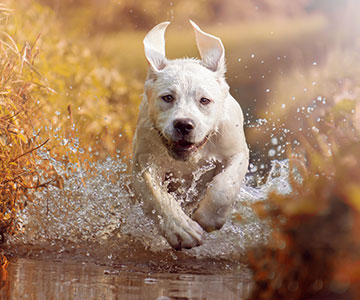
Reasons why your dog might be scared of water
To help your dog get into the water, you should first try to work out why they don’t like it. Then you can change what you do or control the circumstances and environment. Reasons why dogs might be scared of water can be very varied:
- Bad experiences as puppies
- Being confronted with water without preparation
- Big waves in the sea
- Fear of the unknown
- Being scared of drowning after failing in their first attempts to swim
- Water too cold
- Just not a fan of water
Perhaps your dog isn’t scared of water per se, but simply doesn’t like the cold stream they encounter on their daily walk. Try offering them a warmer alternative. Look for a lake in your area, ideally one with shallow access. In summer, shallow waters are a lot warmer because of the sun. Just make sure that there is no blue-green algae in the lake. This is often found in the summer months in particular, when water temperatures are high. Blue-green algae can cause nausea, sickness, diarrhoea, skin irritation, irritated eyes and shortness of breath in both humans and animals. You shouldn’t swim in lakes with obvious blue-green algae growth or with blue-green algae warning signs. When it comes to recognising blue-green algae yourself, you should be aware that it’s not actually blue at all, but a collection of green strands approximately 30 cm below the water’s surface. It will only be found at certain points in the lake, and not everywhere. The Federal Environmental Agency advises entering the water slowly without disturbing the mud. When the water reaches your knees, if you can still see your feet, then you can swim in the lake in this area.
Dogs that are scared of the water or at least have respect for the water literally find that the ground disappears from under their feet. For them, it is very strange not to have solid ground under their paws at first, so it can take a lot of effort to get used to the water while relying on their own swimming movements.
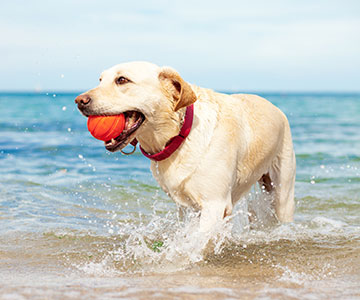
What can you do to help dogs that are scared of water?
So what can you do if your dog doesn’t just run into the river and instead comes to a sudden halt on the river bank out of fear? Whether in water or on land, if you are trying to help your dog overcome a particular fear, the rule of thumb is: keep calm and take small steps. Getting them used to water is no different in terms of process than dealing with other situations where your pet is scared, such as climbing stairs. That’s why you should:
- Stay next to your pet.
- Take small steps.
- Don’t panic – this will only unsettle your dog even more.
- Take their favourite toy with you as an aid.
- Another dog that likes water can also be used as motivation.
- You can also work with swimming aids like a swimming vest to give your dog a greater sense of security.
- And of course, there’s the tried-and-tested method of using treats – you can use a particular favourite treat as a bigger incentive here.
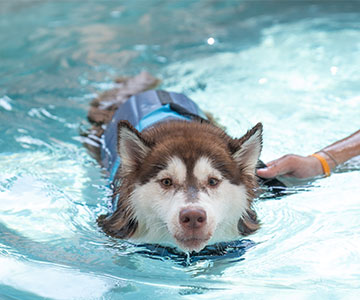
Water training to get dogs used to water
The ideal location for training is a nearby location with water, where your dog is already familiar with the environment. Otherwise, give your dog time to explore a new area to prevent them from becoming over-excited just because everything is new.
Make sure that the water has only a minimal current or small waves, if any at all.This means that bigger rivers or the sea are not suitable for that initial, cautious familiarisation step. On larger rivers in particular, there are waves from passing ships on top of the current and these can hit your dog unexpectedly. As with people, bigger rivers and the open sea should only be used by very strong swimmers who can cope with the current and the waves. Dogs can underestimate the current, jump after their ball or toy and easily be pulled away, which is partly down to lack of experience. If you are playing with your dog in or near the sea, it’s best to make sure that they don’t swallow too much salt water.
Your dog should also be able to get in and out of the water easily. A gently sloping access point, where they can feel their way forward slowly, is ideal. This allows them to get used to the ground and the slowly rising water level, as well as the temperature, too. Otherwise, they can quickly get into a panic because they are scared that they won’t be able to get out of the water again. It is also helpful if the access point isn’t too slippery. Muddy banks do not provide firm footing; solid, stony ground is better.
Take small steps! First, slowly lead your dog up to the water to give them time to get used to it. Pulling your dog into the water on their lead or even pushing them in will not help win them over. In fact, the opposite will happen. Your dog will lose trust in you as a pillar of support and will be scared of having another unprepared and unwanted experience with water if they’re near you.
Help them as they get used to the water and make their first attempts to swim. Hold them around the stomach and chest so that their back end doesn’t sink. This will also allow them to concentrate better on their first attempts to swim. Alternatively, you can use a swimming aid, like a special swimming vest for dogs. Your dog will then have the courage to try swimming on their own.
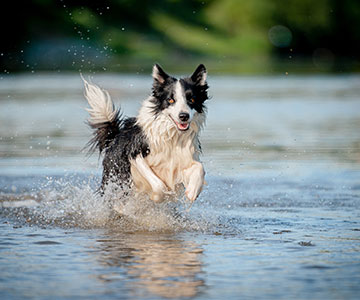
Summary
As with people, dogs have preferences for certain activities. There are some dogs that simply love water in any form, and some who do not enjoy it at all. So it’s not essential for your dog to go into the water or to learn how to swim.
If you want to get help from a professional, there is also the option of taking part in swimming and water familiarisation courses that are offered by many kennel clubs and dog schools especially for dogs. You and your dog will then be introduced to the water with the help of a professional trainer, and your dog might feel more comfortable in the water surrounded by other dogs.
In hot temperatures, not only can your dog cool off in running water, but you can also engage in plenty of activities involving water in your own garden, keeping your best friend happy in the heat, whether they’re a water lover or not. You will find some ideas for easy ways to do this in our guide “Water games for dogs”.
At the same time, there are certainly some breeds that love diving into the nearest river and can’t pass a stream without jumping in it. These dogs might not exactly be enthusiastic at the sight of a little paddling pool that you, as a thoughtful dog owner, set up especially in your own garden for them to cool off. This is less about overcoming fears – your four-legged friend simply might not know what to make of this bit of shallow water that isn’t doing a whole lot of moving. In this case, your dog will probably be happier watching you go for a paddle from a shady spot than actually joining in themselves.
Product recommendation
The benefits of PLATINUM dog food
- PLATINUM uses a unique preparation method called FSG, which offers numerous advantages compared to conventional dog food.
- Dog food prepared with FSG is gently cooked only in its own meat juice and is therefore nutrient-rich like BARF, excellent for building muscles and also extra tasty for your dog.
- With at least 70% fresh meat in the dry dog food and 83% fresh meat or fresh fish in the wet dog food, PLATINUM places great value on a composition of the food that is adapted to the needs of dogs.
- The declaration and composition of dog food prepared with FSG is tested regularly and independently by ELAB Analytik GmbH (formerly TÜV SÜD ELAB) - for canine health protection.
- PLATINUM is generally very well accepted by dogs of all breeds and ages. Even four-legged friends with sensitive digestion or intolerances usually tolerate PLATINUM dog food well.
- All products are free of soya, GMOs and gluten. In addition, no flavour enhancers, attractants, odourants or colourings are used.
- Over 80,000 positive customer reviews at Trusted Shops speak for themselves!


 Deutsch
Deutsch
 English
English
 Nederlands
Nederlands
 Français
Français


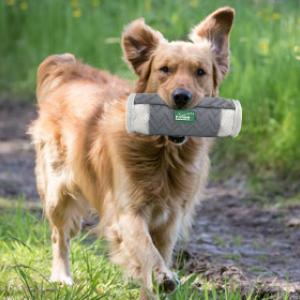
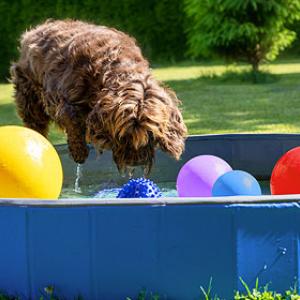

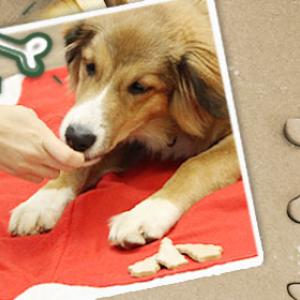
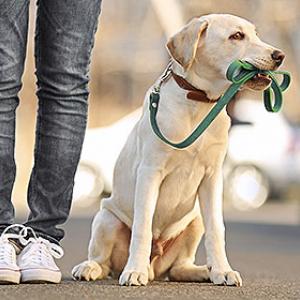

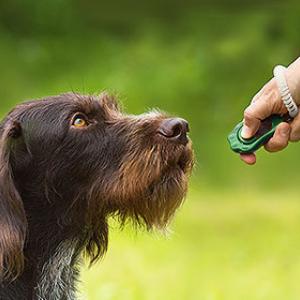

.png)
.png)
.png)
.png)